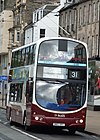
Easter Road is a football stadium located in the Leith area of Edinburgh, Scotland, which is the home ground of Scottish Premiership club Hibernian (Hibs). The stadium currently has an all-seated capacity of 20,421, which makes it the fifth-largest football stadium in Scotland. Easter Road is also known by Hibs fans as "The Holy Ground" or "The Leith San Siro". The venue has also been used to stage international matches, Scottish League Cup semi-finals and was briefly the home ground of the Edinburgh professional rugby union team.

The North Clyde Line is a suburban railway in West Central Scotland. The route is operated by ScotRail. As a result of the incorporation of the Airdrie–Bathgate rail link and the Edinburgh–Bathgate line, this route has become the fourth rail link between Glasgow and Edinburgh.

Edinburgh Waverley railway station is the principal railway station serving Edinburgh, Scotland. It is the second busiest station in Scotland, after Glasgow Central. The station serves as the northern terminus of the East Coast Main Line, 393 miles 13 chains from London King's Cross, although some trains operated by London North Eastern Railway continue to other Scottish destinations beyond Edinburgh.

Portobello is a coastal suburb of Edinburgh in eastern central Scotland. It lies 3 miles (5 km) east of the city centre, facing the Firth of Forth, between the suburbs of Joppa and Craigentinny. Although historically it was a town in its own right, it is officially a residential suburb of Edinburgh. The promenade fronts onto a wide sandy beach.

Gorgie is a densely populated area of Edinburgh, Scotland. It is located in the west of the city and borders Murrayfield, Ardmillan and Dalry.
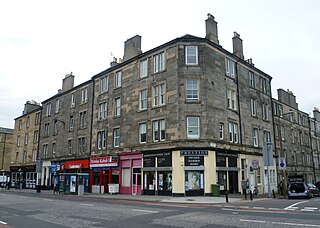
Dalry is an area of the Scottish capital city of Edinburgh. It is located close to the city centre, between Haymarket and Gorgie. The area is now primarily residential. It is centred around Dalry Road, which has numerous shops, restaurants and small businesses. Lying outside the old city walls and west of the castle, the area began as part of the agricultural estate of Dalry House, the exception being the Dalry Mill, recorded as the oldest paper mill in Scotland, now demolished.

Abbeyhill is an area of Edinburgh, the capital of Scotland.
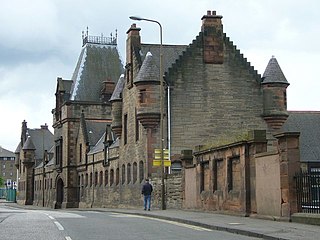
Powderhall is an area lying between Broughton Road and Warriston Road in the north of Edinburgh, the Scottish capital. Until recently it was best known for Powderhall Stadium, a greyhound racing track, which has now closed. The stadium also played host to motorcycle speedway racing from 1977 to 1995, as home to the Edinburgh Monarchs, who have since relocated to Armadale. The Powderhall Sprint, first held in 1870, was a professional footrace with handicapping of the runners. It continues, since 1999, as the New Year Sprint and is now held at Musselburgh Racecourse.
The Edinburgh Suburban and Southside Junction Railway was a railway company that built an east-west railway on the southern margin of Edinburgh, Scotland, primarily to facilitate the operation of heavy goods and mineral traffic across the city. The line opened in 1884. Although its route was rural at the time, suburban development quickly caught up and passenger carryings on the line were buoyant; the passenger service operated on a circular basis through Edinburgh Waverley railway station.
The Lanarkshire and Dumbartonshire Railway was a railway company in Scotland. It was promoted independently but supported by the Caledonian Railway, and it was designed to connect Balloch and Dumbarton with central Glasgow, linking in heavy industry on the north bank of the River Clyde. From Dumbarton to Balloch the line would have closely duplicated an existing railway, and negotiation led to the latter being made jointly operated, and the L&DR terminated immediately east of Dumbarton, trains continuing on the joint section.
The Glasgow to Aberfoyle Line was a railway line in Scotland, built in stages, leaving the Edinburgh and Glasgow Railway near Lenzie. Tourist traffic was a dominant part of the motivation for building the line, and road tours to the Trossachs from Aberfoyle formed a significant part of the traffic.

Leith Central Railway Station was a railway station in Leith, Scotland. It formed the terminus of a North British Railway branch line from Edinburgh Waverley. The station was built on a large scale, and it included a trainshed over the platforms.
Hibernian Park was the home ground of the Scottish football club Hibernian from 1880 until the club's dissolution in 1891. When the club was reformed in 1892, the club took out on a lease on a site which became known as Easter Road. Hibernian Park was also located in the Easter Road area; in fact, it was closer to Easter Road itself than the present stadium because it was on the site of what is now Bothwell Street.
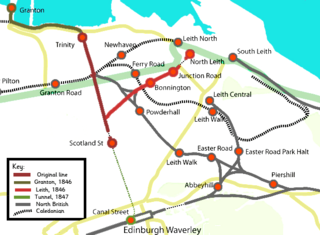
The Edinburgh, Leith and Newhaven Railway was a railway company formed in 1836 to connect the city of Edinburgh with the harbours on the Firth of Forth. When the line connected to Granton, the company name was changed to the Edinburgh, Leith and Granton Railway. It opened part of its route in 1846, but reaching the centre of Edinburgh involved the difficult construction of a long tunnel; this was opened in 1847. It was on a steep incline and was worked by rope haulage.
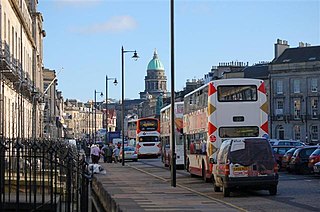
The West End is an affluent district of Edinburgh, Scotland, which along with the rest of the New Town and Old Town forms central Edinburgh, and Edinburgh's UNESCO World Heritage Site. The area boasts several of the city's hotels, restaurants, independent shops, offices and arts venues, including the Edinburgh Filmhouse, Edinburgh International Conference Centre and the Caledonian Hotel. The area also hosts art festivals and crafts fairs.
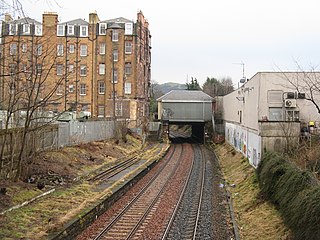
Morningside Road railway station is a former railway station in the Morningside area of Edinburgh, Scotland. Originally named Morningside Station, it was opened by the Edinburgh Suburban and Southside Junction Railway (ESSJR) in 1884 and closed to passengers in 1962. The station buildings still remain, and the railway track is still in use.

Piershill railway station was a railway station in Edinburgh, Scotland, on a loop off the main line. It was opened on 22 March 1868.

The Blane Valley Railway was a railway line in Scotland to the east of Glasgow. It is now closed. In 1891 the railway company was absorbed by the North British Railway, which had operated the line and been a major shareholder from the start. When NBR took over the line was in a poor state. The goods shed was inadequate for the amount of traffic, the only crane was too small and siding accommodation was deficient. There was considerable potential for the transportation of cattle in the area but there were no facilities in place. Capital was invested and the line transformed. The locomotives were cleaned and the stations given a makeover. Close attention was given to the cleanliness of staff and the neatness of their uniforms. The railway was the only means of transport for the people living in the area and was a source of much pride. In 1923 following the grouping it became part of London and North Eastern Railway. Following nationalisation in 1947, it was taken over by British Railways. Unable to compete in the face of road competition, the line was closed to passengers in 1951 and closed completely in 1959.

Leith Walk railway station was a railway station located on Leith Walk in Edinburgh. In order to build the station, the Gallow Lee, which was once the site of public executions, was excavated. The station opened on 22 March 1868 and was served by trains on Edinburgh local rail services. During World War I the station was closed as an economy measure between 1 January 1917 and 31 January 1919. The station closed to passengers on 31 March 1930. It is likely that this was due to competition from Edinburgh Corporation Tramways as the tram journey from the city centre to Leith Walk was quicker than travelling by train. Passenger trains continued to serve other stations on the line until 1947.

Easter Road Park Halt railway station was a railway station located in Lochend, Edinburgh, Scotland from 1950 to 1967 on the Leith Central Branch. It was built to serve the nearby Easter Road stadium.

















